Well, it’s back. Most people probably didn’t know it was gone.
The Toyota Venza.
It’s been absent from Toyota’s roster of models since the 2015 model year, probably because Americans, for whatever reason, just aren’t much into station wagons – which is what the first generation Venza was.
They are into crossovers – particularly those made by Lexus such as the very popular RX350. The problem there is Toyota doesn’t sell that model under its own label.
Enter the new Venza – which is very similar not only to the RX350 but even more like the RX450h, the hybrid version of that model.
Just a bit (but not that much) smaller.
And a lot smaller-priced.
What It Is
The new Venza – unlike the old Venza – isn’t a higher-riding, wagonized Camry. It looks a lot like – is laid out a lot like – the Lexus RX, which is a mid-sized luxury crossover SUV. The Venza is slightly smaller than the mid-sized RX but only by about six inches in length, has comparable room inside for passengers – and much more room inside for cargo.
Unlike the RX, it also comes standard with a hybrid powertrain and all-wheel-drive – for $32,670 to start vs. $45,220 for the base (non-hybrid and front-wheel-drive) RX350.
The hybrid RX450h (which comes standard with AWD) starts at $47,920.
This is nearly $8k more than the $40,000 Toyota charges for a top-of-the-line Venza Limited, which comes with a massive 12.3 inch touchscreen that’s the same size and type as the one in the Lexus RX450h, a similar JBL premium audio system with nine speakers, heated/ventilated seats and heated steering wheel, simulated leather trim, a 360 degree bird’s eye surround-view camera system and a huge panorama glass roof that auto-dims at the touch of a button.
It does not have the RX hybrid’s more powerful V6 engine – but it also doesn’t come with a weak engine. Or the extra cost you pay for the Lexus badge vs. Toyota.
Even though both are made by the same company.
What’s New
The Venza name isn’t but the vehicle it’s affixed to is.
What’s good
Excellent fuel efficiency.
Compares favorably, functionally and visually, to the much more costly Lexus RX450h hybrid.
Goes twice as far as an electric-only crossover – and doesn’t force you to stop and wait for a recharge when you run low on gas.
What’s Not So Good
Much less cargo space than in the old Venza.
LCD screen’s smartphone-style touch inputs are harder to use accurately while driving than physical knobs and buttons you don’t have to look at to operate.
Driver “assistance” tech can’t be skipped.
Toyota has sold vast fleets of hybrids, especially the Prius. But the price you pay for 50-plus MPG capability is not being able to get to 60 very quickly. It is one of the reasons why some buyers looking for a hybrid that isn’t so slow – and one that doesn’t look like a Prius – walk across the street to the Lexus store. There you can find hybrids that don’t look like a Prius – and that gets to 60 in good time, too.
The Venza attempts to bridge that gap.
It comes standard with a 2.5 liter four cylinder gas engine paired with electric motors and a battery pack to power them – which gets recharged as you drive, by the gas-burning engine, so you never have to stop to plug in. The combo makes 219 horsepower, sufficient to get the Venza to 60 in about 7.5 seconds – which is about three seconds quicker than it takes a Prius, which has a 1.8 liter gas engine and 121 horsepower, to get to 60.
It is also enough to get 40 miles-per-gallon in city driving and 37 on the highway. This is not as fuel-sippy as the Prius – which averages 50-plus MPG in city and highway driving. But it is much better than the Lexus RX450h’s 31 city, 28 highway – and compares very favorably with the hybrid Lexus’ 7 second 0-60 time slip.
Half a second’s difference isn’t all that much difference.
Perhaps the most favorable comparison of all is with electric luxury crossovers such as the $71,310 Audi e-Tron, which is a little larger overall but has virtually the same room inside for people and cargo. It is much more powerful – and quicker – but it can only go 222 miles before it forces you to stop for a long time (10 hours on 240 volts) to recharge. If you can find what is styled a “fast” charger, the recharge time is reduced to “only” 30-45 minutes.
Assuming you don’t have to wait for the car ahead of you to finish “fast” charging.” Assuming you don’t mind not being able to go home to wait while it recharges.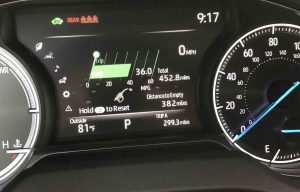
And that’s only for a partial recharge, as it is unsafe to fully “fast” charge an electric car because of the fire risk and the risk of damaging the battery pack. So you get about 80 percent of the original 220 after 30-45 minutes.
Meanwhile, the Venza hasn’t had to stop once. It can travel 580 miles (city) before it needs a top-off, which you can complete (completely) at any gas station in less than 5 minutes, which is what fast used to mean, when words still had meaning.
Hybrids like the Venza are thus practical as well as efficient. And they are probably better for the environment, if that is a concern, since they do not require 1,000-plus pounds of electric battery pack made of rare earth substances such as Cobalt and Lithium, which are extracted and processed in very environmentally unfriendly ways in countries with very lax, if any, environmental (or child labor) regulations.
Hybrids also do not consume enormous amounts of electricity generated by electric utility plants, most of which burn oil, coal or natural gas to generate it. Instead, they use a small, highly efficient gas burning engine to self-charge a much smaller battery pack that requires less energy and so costs less, environmentally. The hybrid’s battery pack is also likely to last longer because it is used only part-time and also because the hybrid system prevents total or near-total discharge, which is very hard on electric batteries and reduces their service life.
The gas engine, meanwhile, isn’t even running half the time – and when it does, it emits practically nothing that’s meaningfully objectionable, environmentally. There is only the psychological (and political) objection – which ought to be objected to, since hybrids make sense while electric cars do not. 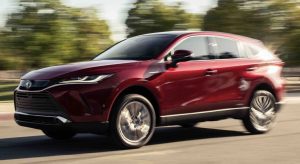
On The Road
The rule of 10,000 hours applies. It is said it takes that long, at least, to become adept at anything. Toyota has put in more than 10,000 hours developing hybrids, which they’ve been selling longer than anyone else.
It shows. Or rather, it feels.
The Venza’s transitions between gas and electric (and both, together) operation are smoother than a politician’s press conference but in this case, no one’s trying to hide anything.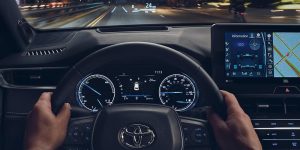
Initially, the Venza emulates the electric car’s silent running. When you turn it on, nothing mechanical happens. Just dashboard lights, to let you know it’s ready to go. You glide away on battery power, which powers the electric motors. As you drive, the gas engine will come online to supplement – and to recharge. It is almost impossible to discern these yin-yang handoffs without referring to the visual display in the dash that shows you what’s happening, in case you’re interested.
More interesting is the Venza’s performance, which – unlike that of the Prius hybrid – is equal to today’s driving conditions.
The Prius is a fine car but it has trouble keeping up with today’s fast-paced driving conditions, especially highway speed limits of 70-75 and traffic routinely moving a lot faster than that. Merging with such traffic can be harrowing when all you have under the hood is 121 horsepower. Even keeping pace with it is a challenge. The Prius, at 75, is sweating; it takes practically all the power it has just to maintain such speeds. The Venza maintains 80 easily. It merges with traffic going that fast without sweating – and with enough reserves to pass traffic dawdling along at 70.
Some people dislike CVT automatic transmissions because of their lack of feel – and their sound. The latter is mostly a function of the engine – of it being underpowered, which keeps the CVT in a range that approximates the engine’s power peak, which is usually south of 4,000 RPM. Hence the racket whenever you attempt to accelerate in an underpowered, CVT-equipped car like the Prius.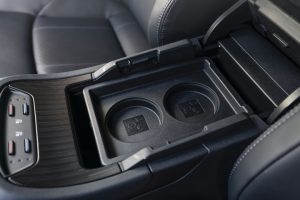
But if there is enough engine, the CVT is generally quieter than a conventional automatic because it keeps the engine running at lower RPM, in order to maximize efficiency. That is the case here. The Venza’s drivetrain is very quiet – and also very smooth, precisely because the CVT does not shift between gears but transitions silkily between ranges.
In a sporty vehicle, that snappy gear-changing shift feel is desirable. But the Venza is a luxury vehicle, in form and function.
Just not badge – or price.
The steering is light and precise – and the suspension is pretty soft, so the cornering limits aren’t high. But that’s not what the Venza is about. This is a Lexus in Toyota drag, something to lock out the world on your way to work.
Let’s compare the Venza to the Lexus RX it looks so much like.
The Venza is a little smaller overall, but not by much. It is 186.6 inches long vs. 192.5 for the Lexus; this difference of 5.9 inches in length is sufficient to classify the RX as mid-sized while the Venza is closer to compact.
But now let’s compare what’s inside.
The Venza has 40.9 inches of front seat legroom and 37.8 inches of rear seat legroom – vs. 44.1 up front in the Lexus and 38 in the second row. So, advantage there – but not that much. Especially since few people except really tall people ever extend the front seat as far back as it can go.
Now the big one – cargo capacity – which isn’t adjustable.
The Lexus only has 16 cubic feet of space for it behind its second row and with its second row folded, that expands to just 32.6 cubic feet. The Toyota RX – whoops, Venza – has 28.8 cubic feet behind its second row and 55.1 cubic feet with them down.
Then there are the Lexus-level amenities available in this Toyota, including something very special because it’s so unusual: A Star Gaze sheet-glass panorama roof that can be semi-opaqued at the touch of a button, to let some – but not too much – sun in. It is like having regular and frosted glass in the same glass.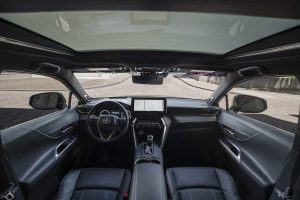
There is also the available (standard in Limited trims) 12.3 inch LCD touchscreen, identical in size to the unit in the RX. And a digital rearview mirror that lets you fully load the cargo area even to the extent of obscuring your view – and still be able to view – via a remote-view camera system. If you opt for the Technology package, your Venza will have a 10-inch color Heads Up Display (HUD) and rain-sensing wipers.
You can’t order it with Lexus RX450h badges. But there’s no law preventing you from buying them over the counter and affixing them to your Venza.
And nine out of ten people would never be able to tell the difference.
The Venza does not have the RX’s elegant-looking but awkward-to-use mouse trackpad input system on the center console. But it does have smartphone-emulating tap/touch inputs on the big LCD screen.
The problem with these is the same as the problem with those on your phone. Making inputs requires looking at what you’re tapping, else you’ll probably tap something else. This means looking away from other things – like the road. It is why knobs and buttons you can feel are better when you’re driving – and the good news here is that the Venza has them, too. At least, for some of the functions – such as adjusting the volume of the stereo system and channels (via thumb buttons on the steering wheel).
But other functions – such as adjusting the AC or heat and fan – must be done via tapping the touchscreen – if you opt for the big screen. Models with the smaller/standard (8-inch) screen come with rotary knobs to control the AC, heat and fan.
One thing you can’t opt out of is the suite of driver “assistance” tech, including Lane Centering Assist and Forward Collision Mitigation, the former nudging you back into your travel lane if the car thinks you’re inadvertently wandering, the latter applying the brakes if the car thinks you aren’t braking when it thinks you should be.
The Bottom Line
If you like the Lexus RX but would rather not pay for it, Toyota may have most of what you’re looking for.
As well as some more!
. . .
Got a question about cars, Libertarian politics – or anything else? Click on the “ask Eric” link and send ’em in! Or email me at [email protected] if the @!** “ask Eric” button doesn’t work!
If you like what you’ve found here please consider supporting EPautos.
We depend on you to keep the wheels turning!
Our donate button is here.
If you prefer not to use PayPal, our mailing address is:
EPautos
721 Hummingbird Lane SE
Copper Hill, VA 24079
PS: Get an EPautos magnet or sticker or coaster in return for a $20 or more one-time donation or a $10 or more monthly recurring donation. (Please be sure to tell us you want a magnet or sticker or coaster – and also, provide an address, so we know where to mail the thing!)
My eBook about car buying (new and used) is also available for your favorite price – free! Click here. If that fails, email me at [email protected] and I will send you a copy directly!


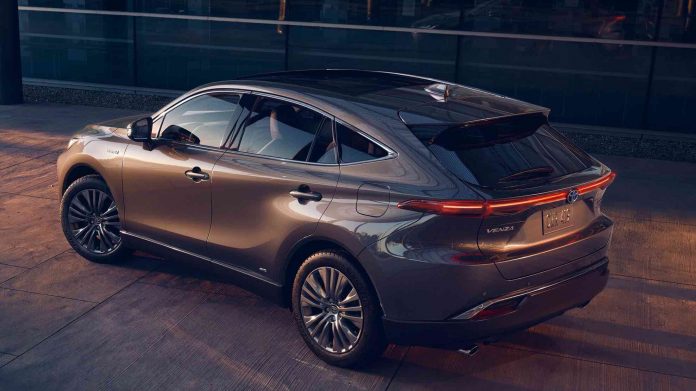


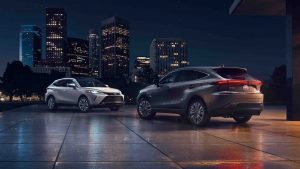










“Starting the Venza results in a futuristic whirring sound designed to warn pedestrians that an electrified vehicle is operating nearby. It grabs attention, and people certainly took notice of this Toyota. However, this is no doubt in part because many people hadn’t seen the new Venza before.”
Oh hell no
JD Powe.com
This comment is too short. Well I forgot to source my quote.
You did not go into my biggest concern, as you have done in the past.
You cannot skip driver assists. But can they be turned off and stay off?
I’m with you on the screen subbing for control knobs. Horrible. Rented a Ford Edge, which is probably a competitor to the Venza. Lots of room in the Edge, and I’m glad it was in the rental – we needed all that room on our trip! But was turned off by all the tech. I guess I’m a Luddite after all.
Hi Tom,
I don’t think it’s symptomatic of being a Luddite to object to tech that replaces a simple, effective control with one that is complex and less effective. A knob or switch can be operated by feel; it has positive engagement. It works. It works better than attempting to tap or swipe a glowing icon on a screen that you cannot feel and that has no positive engagement. Which you have to at least glance at in order to use accurately.
Yes: I found myself having to look at the damn screen for an uncomfortable amount of time to make any adjustment. Especially nerve-wracking in SoCal 80+mph freeway traffic!
Although this new Venza is a “nice” vehicle, it’s not going to stir up much buying excitement. Like the first version, it too probably will be discontinued.
Toyota really found The Magic Touch with their Cressidas, Coronas and Tacomas. But just like Venza 1.0, the 2021 version just doesn’t seem to have ” it.”
“Well, it’s back. Most people probably didn’t know it was gone.”
That made me laugh because it was true. And then I read an article about a car I am not in the market to buy. I enjoyed the review. Thanks Eric.
Toyota lost me at “Driver “assistance” tech can’t be skipped.”
I agree, Dan.
I didn’t know there even – is – a Venza, let alone that its gone & come back. (Venza ~ Vega, hmmm. Might as well be a Bluebird, I guess.)
Anyway, I also didn’t know cars have a 360 degree bird’s eye surround-view camera system and a huge panorama glass roof that auto-dims at the touch of a button. I guess I need to read more of Eric’s reviews in the future in order to keep up with all the features in today’s appliances, er I mean, autos.
You’re not the only one who didn’t know there was a Venza
‘adjusting the AC or heat and fan must be done via tapping the touchscreen – if you opt for the big screen. Models with the smaller/standard (8-inch) screen come with rotary knobs to control the AC, heat and fan.’
Ergonomically, the smaller screen with rotary knobs is obviously superior.
Only pseudo-sophisticated, smartphone-addled digirati would pay up for a bigger screen that takes away manual controls.
I don’t want no smartphone on wheels. Alexa … off yourself.
Hello Eric… A small tip for the video.
If you open the door with the lights on turn off the lights or else the beeper sound destroys the video!